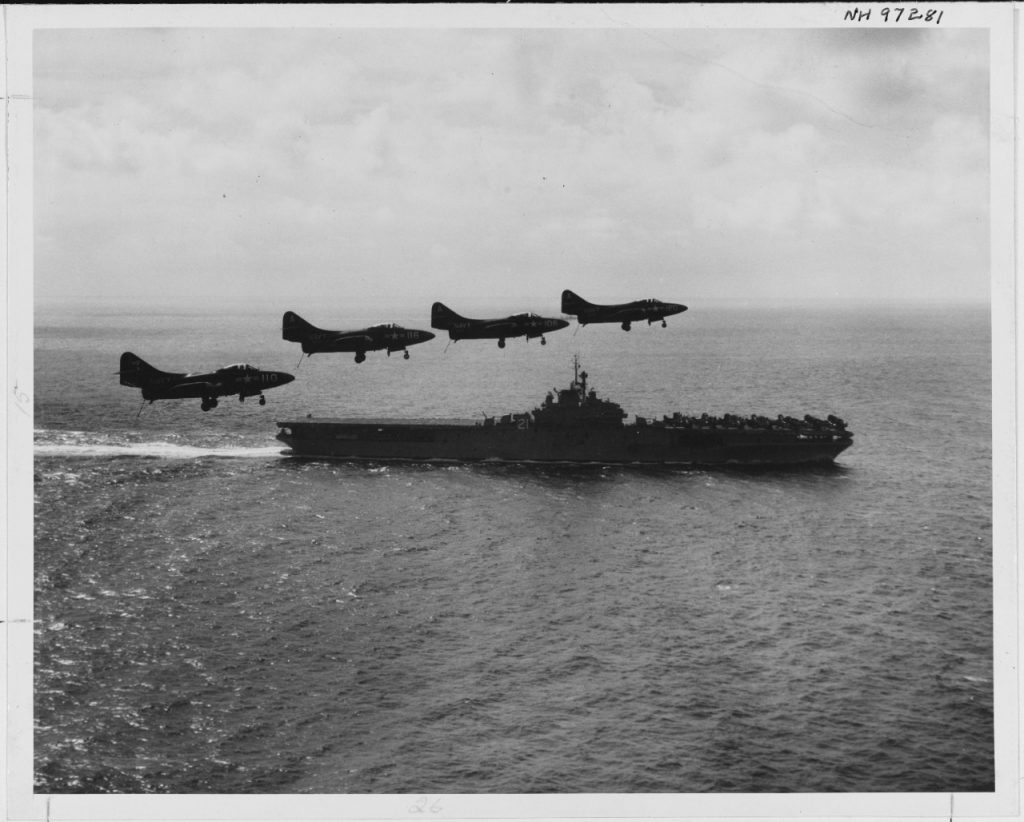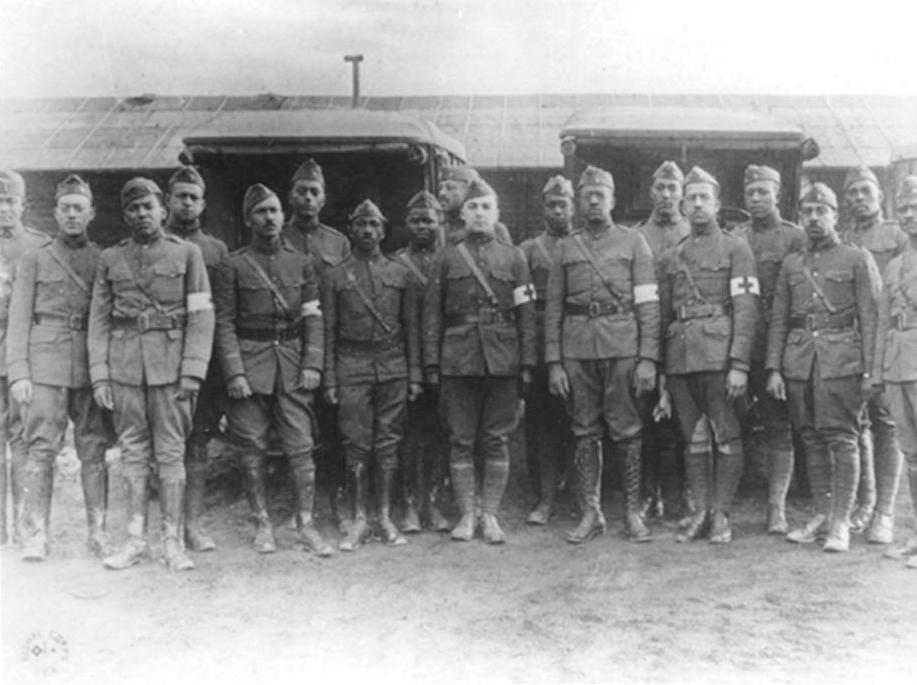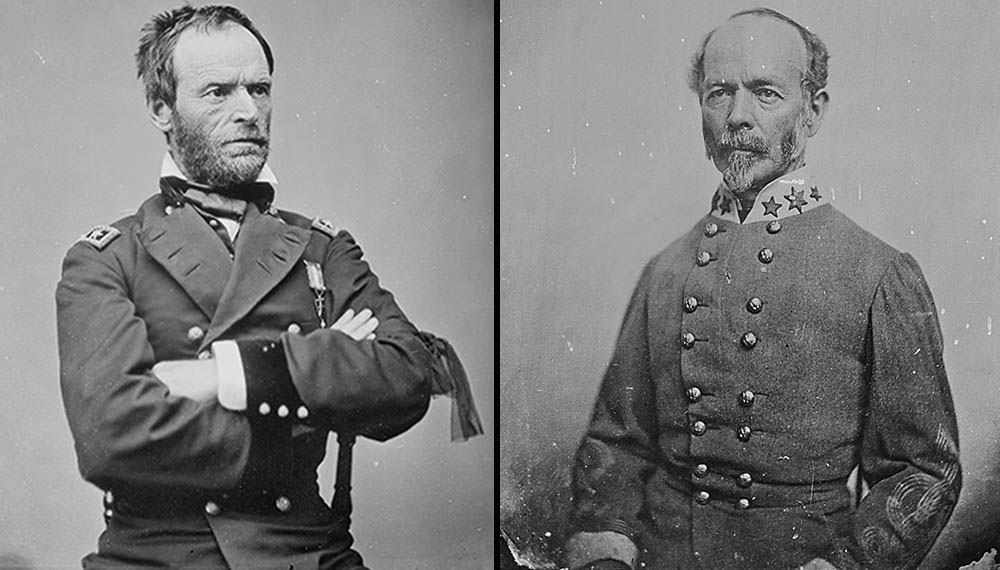
APRIL 2, 1951
First U.S. Navy jet aircraft utilized as a bomber
First U.S. Navy jet aircraft utilized as a bomber is launched from the USS Princeton. Two F9F-2B Panthers catapulted from the Princeton to attack a railroad bridge near Songlin, North Korea.

APRIL 3, 1948
President Harry Truman signed the Economic Cooperation Act of 1948
President Harry S. Truman signed legislation authorizing the Economic Cooperation Act of 1948. Today, we refer to this legislation as the Marshall Plan in honor of George C. Marshall Jr., a General of the U.S. Army and the Secretary of State when the document was signed. The goal of the Marshall Plan was to both stabilize and reinvigorate the economy of Western Europe after the destruction of World War II. The Marshall Plan provided over $12 billion dollars in economic assistance to the Western European economy. Eventually, the Marshall Plan was replaced with the Mutual Security Act of 1951, also enacted by the Truman Administration, with the goal of economically lifting less developed countries up to prevent the spread of communism throughout the world.

APRIL 5
Gold Star Spouses Day
Gold Star Spouses Day is observed. The first Gold Star Spouses Day began as Gold Star Wives Day in 2010. It was later changed to be more inclusive. The term Gold Star has its origins from the service flags and banners that were first flown by families during World War I. They represented a blue star for family members serving in the armed forces and a gold star if their family member made the ultimate sacrifice during service. This day brings awareness about the sacrifices and grief spouses face. It is a reminder for all of us to remember them and their loved ones on this day and every day.

APRIL 6, 1917
Coast Guard service is transferred to the Navy
When the U.S. enters World War I, Coast Guard service is transferred to the Navy. The United States declared war on Germany, nearly three years after World War I started. On the same day, the U.S. Navy’s communications center in Arlington, Virginia, transmitted the code words “Plan One, Acknowledge,” to Coast Guard cutters, units and bases initiating the Coast Guard’s transfer from the Treasury Department to the Navy and placing the service on a wartime footing.

APRIL 9
National Former Prisoner of War Recognition Day
National Former Prisoner of War Recognition Day honors all who were Prisoners of War (POWs). This day of remembrance occurs on the anniversary of the Bataan Death March. On April 9, 1942, U.S. armed forces surrendered to Japanese forces on the Bataan Peninsula in the Philippines. On that day the Imperial Japanese Army forced American and Filipino POWs to march 65 miles. During this exodus, the POWs were beaten, robbed, starved, tortured and executed by Imperial Japanese service members. It is estimated over 20,000 men died during the march. Those who did not perish suffered cruel treatment for two years as POWs before they made it back to the United States. Today is a reminder of their service and sacrifice.

APRIL 9, 2003
U.S. forces captured Baghdad during the Iraq War
U.S. forces captured Baghdad during the Iraq War. The Battle of Baghdad, later known as the Fall of Baghdad, was a military invasion of Iraq that took place in early 2003. On April 9, just three weeks into the invasion, U.S. forces toppled a large bronze statue of Saddam Hussein overlooking Baghdad’s Firdos Square. With Hussein in hiding and much of the city now under U.S. control, this moment came to symbolize the end of the Iraqi president’s long, often brutal reign, and a major early victory for the United States.

APRIL 12, 1861
First shots of the Civil War
The first shots of the Civil War occured when Confederate forces fired on Fort Sumter. The resupply of Fort Sumter became one of the first crises of President Lincoln’s administration. He notified the Governor of South Carolina, Francis W. Pickens, that he was sending supply ships, which resulted in an ultimatum from the Confederate government for the immediate evacuation of Fort Sumter. Confederates bombarded the fort from artillery batteries surrounding the harbor, thus causing the Battle of Fort Sumter.

APRIL 12, 1865
Confederate General Lee surrendered to Union General Grant at Appomattox Court House
Confederate General Lee surrendered to Union General Grant at Appomattox Court House. “It would be useless and therefore cruel,” Robert E. Lee remarked on the morning of April 9, 1865, “to provoke the further effusion of blood, and I have arranged to meet with General Grant with a view to surrender.” Rather than destroy his army and sacrifice the lives of his soldiers, Lee surrendered the Army of Northern Virginia. Three days later, a formal ceremony marked the disbanding of Lee’s army. On April 9, 1865, at the home of Wilmer McLean in the village of Appomattox Court House, Virginia, General Lee formally surrendered to Union General Ulysses S. Grant bringing an end to the bloodiest conflict in American history. This happened just over four years after the Confederate bombardment of Fort Sumter, which then led to the first land battle at Manassas, Virginia, later that year.

APRIL 14
Air Force Reserve Birthday
Air Force Reserve celebrates its 74th Birthday. Since President Harry S. Truman called for the formation of the Air Force Reserve in 1948, it has been a critical part of the nation’s defense. We honor the more than 82,000 men and women who provide combat ready forces to Fly, Fight and Win.

APRIL 16, 1862
Emancipation Day is celebrated in the District of Columbia
Emancipation Day is celebrated in the District of Columbia. President Abraham Lincoln signed the Compensated Emancipation Act, which effectively abolished slavery in the District of Columbia. Slavery in other parts of the United States came to an end in 1865.

APRIL 18
Patriots’ Day
Patriots’ Day commemorates the battles of Lexington, Concord and Menotomy, some of the first battles of the American Revolutionary War. It occurs on the third Monday of April each year, including battle reenactments and the Boston Marathon in Massachusetts.

APRIL 18, 1988
U.S. launched Operation Praying Mantis, the largest naval battle since World War II
The United States launched Operation Praying Mantis against Iranian targets, the largest naval battle since World War II. The operation was launched in retaliation of the placement of mines in the Persian Gulf during the Iran-Iraq War. The guided missile frigate USS Samuel B. Roberts struck a mine four days earlier, blowing a 15-foot hole in the ship’s hull. The ship should have sunk, but thanks to an extraordinary damage control effort by all hands of an extremely well-trained crew, the ship was kept afloat. Operation Praying Mantis was the largest of five major U.S. Navy surface actions since World War II. It was the first, and so far only, time the U.S. Navy has exchanged surface-to-surface missile fire with an enemy. In the one-day operation, the U.S. Navy destroyed two Iranian surveillance platforms, sank two of their ships, and severely damaged another.

APRIL 19, 1775
The Battles of Lexington and Concord were the first military engagements of the American Revolutionary War
The first military engagements of the American Revolution were the battles at Lexington and Concord. About 700 British Army regulars in Boston were given secret orders to capture and destroy Colonial supplies stored by the Massachusetts Militia at Concord. Through intelligence gathering, Patriot leaders had received word weeks ahead and moved most of it to other locations. On the night before the battle, warning of the British expedition had been rapidly sent from Boston to militias in the area by several riders, including Paul Revere, with information about British plans. The initial mode of the Army’s arrival by water was signaled from the Old North Church in Boston using lanterns to communicate “one if by land, two if by sea”. The first shots of battle were fired just as the sun was rising at Lexington. Ralph Waldo Emerson describes the first shot fired by the Patriots at the North Bridge as the “shot heard round the world.”

APRIL 23
U.S. Army Reserve Birthday
U.S. Army Reserve celebrates its 114th Birthday. In 1908, the Army Reserve began as a small corps of medical professionals held in readiness for duty. Today, they serve as the Army’s global operational reserve force with a presence in 50 states, five U.S. Territories and 20 time zones across the globe. We recognize the more than 188,000 soldiers that protect our nation.

APRIL 23, 1908
Medical Reserve Corps is created
Congress passed legislation that created the Medical Reserve Corps, the Army’s first Federal Reserve force. Congress created the Medical Reserve Corps to increase the Medical Department of the U.S. Army’s efficiency. The Army’s Medical Department would now consist of both a Medical Corps and a Medical Reserve Corps thereby increasing the number of medical professionals available for soldiers serving on the front lines.

APRIL 25, 1960
USS Triton completed the first submerged circumnavigation of the globe
The U.S. Navy submarine USS Triton completed the first submerged circumnavigation of the globe. Dubbed “Operation Sandblast,” the mission was conducted by the nuclear-powered submarine USS Triton, and was done for purposes of geophysical and oceanographic research. Commanding the submarine was Captain Edward L. Beach Jr., who already forged a stellar naval career to that point. The son of Edward L. Beach Sr., a U.S. Navy captain, Beach Jr.’s career spanned from 1939-1966, and during this time he was awarded the Navy Cross, two Silver Stars and two Bronze Stars, among other commendations.

APRIL 26, 1865
Confederate General Johnston accepted terms of surrender to Union General Sherman at Bennett Place
Confederate General Joseph E. Johnston accepted terms of surrender to Union General William T. Sherman at Bennett Place near Durham, North Carolina. Following Lee’s surrender and the assassination of Lincoln, Sherman met with Johnston on April 17, 1865, to negotiate a Confederate surrender. At the insistence of Johnston, Confederate President Jefferson Davis and Confederate Secretary of War John C. Breckinridge, Sherman conditionally agreed to generous terms. On April 20, Sherman sent a memorandum of those terms to Washington to prevent Johnston from ordering his men to go into the wilderness and conduct a destructive guerilla campaign. However, Sherman proceeded without Grant’s authority as well as President Johnson’s and his Cabinet. Grant intervened to save Sherman from dismissal and offered Johnston purely military terms, like those negotiated with General Lee. Johnston accepted those terms and then formally surrendered his army and all the Confederate forces in the Carolinas, Georgia and Florida.



